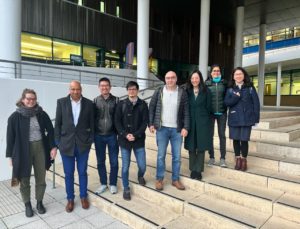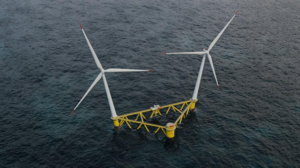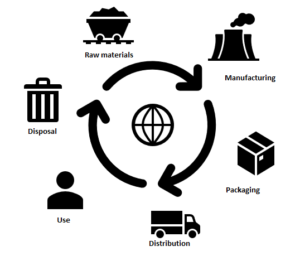

Authors – Justin Olosunde (Project Lead) and Professor Lars Johanning (the Deputy Head of Engineering and Co-Director Centre for Doctoral Training in Offshore Renewable Energy at the University of Exeter)
The Cornwall and Isles of Scilly Local Enterprise Partnership (CIOS LEP) have identified the Cornwall and Scillies region as the birthplace of commercial wind generation in the UK. It has one of the best wind climates in Europe and has committed to the UK Government agenda as one of only two places in the UK singled out by the Government’s Net Zero Strategy for large-scale FLOW deployment. Some 300MW of projects are already moving forward, with a 30–40MW demonstrator expected to be on-site by 2025.
“The LEP has set a target of 3GW of installed capacity, which could support more than 11,000 jobs and generate £900 million of net additional gross value added.”
~ Mark Duddridge, Chair of The Cornwall and Isles of Scilly Local Enterprise Partnership, 2021
Celtic Sea Power is leading the Cornwall Floating Offshore Wind Accelerator, a part European Regional Development Funded project, which will develop tools, knowledge, and data to accelerate the Celtic Sea FLOW opportunity. They hope to lay the significant groundwork to develop a pipeline at both a FLOW project and supply chain level. The University of Exeter, University of Plymouth, and the Offshore Renewable Energy Catapult have partnered to achieve this. Here at the University of Exeter, we are working toward designing, developing, and building a floating offshore wind simulator as a vehicle to help provide research-led expertise to reduce carbon footprints and underpin the FLOW service.
Partnerships created between the University of Exeter and external partners are contributing toward the development of tools, knowledge, and data that accelerate the Celtic Sea FLOW opportunity. These partnerships are laying significant groundwork, with respect to developing a pipeline at both a FLOW project and supply chain level.
A team within the University of Exeter are undertaking research on Floating Offshore Wind via the Cornwall FLOW accelerator, which is a part of The European Regional Development Fund (ERDF) programme. The programme is led by Celtic Sea Power, a wholly owned subsidiary of Cornwall Council. Justin Olosunde, The Impact and Partnership Development Manager for Cornwall FLOW Accelerator and Lars Johanning, the Deputy Head of Engineering and Co-Director Centre for Doctoral Training in Offshore Renewable Energy at the University of Exeter, are part of the Exeter team leading on the design of the tool, to develop a floating offshore wind simulator as a vehicle.




¹ Team photo for the Exeter floating offshore wind simulator team. Left to right: Jessye Boulton, me, Dr Hailun Xie, Dr Barton Chen, Professor Lars Johanning, Dr Mi Tian, Dr Kanchan Joshi and Dr Shuya Zhong.

² Floating offshore wind turbines identified for Hexicon Celtic Sea development site (RenewablesNow
The Eᶜ simulator is a software tool, used to assess economic values and the environmental impacts of floating offshore wind farms. The assessment is based on life cycle analyses, which include five development stages: pre-development, manufacturing, assembly and installation, operations and maintenance, and decommissioning.
This tool is designed to help stakeholders such as wind farm developers and policymakers in decision-making processes in FLOW development. The aim is to enable the effective optimization of the maximum energy yield from any proposed development locations, while minimising the carbon intensity, associated net environmental impact and cost of electricity generation.
A holistic model has been established to encapsulate the whole procedure in assembly and installation of FLOW, including the transport of major FLOW components (tower, blades, nacelle, mooring system, cables, and floating platforms) from manufacturing port to assembly port. This involves the assembly
of wind turbine generators at assembly port, the transit from assembly port to installation port, and the installation at the farm site.
The installation tasks are classified into four categories, i.e., assembly at the port, offshore installation, installation on the seabed, and onshore installation. Three assembly activities at ports or shipyards are considered, including wind turbine assembly, storage of mooring chains, and storage of anchors. The offshore installation includes the transport activities from manufacturing to assembly port, transport activities between installation port and to farm site, as well as offshore operations for installing wind turbines and the mooring system. Installation on the seabed considers the installation of inter-array and export cables, being the cables connecting the wind turbines to one another.
Lastly, onshore installation is dedicated to the installation of onshore substations and export cables. Various types of vessels are employed for the installation of components, such as tugboats, cargo vessels and crane vessels, dependent on specific tasks. The impact of weather conditions on maritime operations is considered by simulating the vessel transit and operation time for wind farm installation, maintenance, and end-of-life decommissioning operations. Additionally, the fuel consumption rates of each vessel for vessel transit and operation are considered separately. A similar environmentally conscious approach is deployed for the analysis of FLOW decommissioning, where the research team considers the recycling and recovery of materials at end of life.
During the maintenance life of the floating offshore wind farms (approximately 25 years), approaches are being taken to account for uncertainties in the failure of them operating effectively. Statistical techniques are being used to determine any uncertainties in the development of the models. The team is currently exploring surrogate-based methods and representative learning approaches to achieve an effective trade-off between computational cost and model fidelity. The hope is to ensure the simulator can be used commercially and by policymakers, to inform investment decisions and future offshore industrialisation, both with confidence and within reasonable timeframes. The impacts of metocean conditions at various locations on vessel accessibility and transit time are determined for all of the offshore operations. This is to ensure the generation of real-world results in terms of both economic costs and carbon emissions. Only by adopting the “cradle to the grave” approach outlined can stakeholders be assured that the major impacts are being captured for any individual wind farm development or series of developments.

3 Cradle to grave life cycle model (University of Exeter, 2022)
Once fully developed and implemented, this tool will allow the optimisation of wind farm design and the planning of multiple windfarms at regional spatial levels. Consideration will be taken into the potential impact of installation, decommissioning, and marine maintenance operations on marine-based flora and fauna. Additionally, solid metrics will be determined on the lifetime costs of energy production, the lifetime carbon costs, and the total energy returned as a ratio to the total energy invested at an individual farm level.
There is a proposed extension of the tool, to further support the modelling of seabird habitat use and how they interact with wind farms. The aim is to use the existing tool to test a series of different wind farm configurations (orientation, spacing of turbines, etc), to provide guidance on those designs that give economic yields, while at the same time minimising their impact on seabirds. Investigations could be taken to discover how to mitigate against the potential losses of birds to wind farm installations by compensation mechanisms, such as the creation of new breeding areas, bycatch reductions methods, or invasive species eradications. The final tool output can inform the creation of a UK-wide risk map that highlights areas around the UK where wind and seabird interests align, to inform wind-farm planning and development policy at a national level.
Having a tool that allows developers and policyholders to virtually explore the interactions between one or more farms at a sea-scape level, enables us to plan wildlife corridors within a farm or between farms, enabling populations to flourish. The approach can inform where and where not to develop and evaluate the associated impact on the cost of generation and energy yield. Generally, this tool will provide valuable information to further inform policy decisions and potentially drive investment in the local supply chains. Multiple scenarios can be evaluated within the simulator, enabling the alignment of low carbon power generation, with the development of local content manufacturing, assembly, and marine operations supply bases. This tool has great potential to help guide environmental impact assessments, whilst also providing a source of energy across the region.


Many thanks to the floating offshore wind simulator team at the University of Exeter for contributing this research to and the Cornwall FLOW Accelerator for leading this project.
References:
1. Team photo for the Exeter floating offshore wind simulator team Image taken at the University of Exeter, Penryn, Cornwall, 2022
2. Sweden’s Hexicon buys consented Celtic Sea site for floating wind demo. Renewablesnow.com. 2022. Available from: https://renewablesnow.com/news/swedens-hexicon-buys-consented-celtic-sea-site-for-floating-wind-demo-749519/
3. Cradle to grave diagram, created by the University of Exeter, 2022.
